Discover 11 hidden attractions, cool sights, and unusual things to do in Indiana Dunes National Lakeshore (United States). Don't miss out on these must-see attractions: Pinhook Bog, Joseph Bailly Homestead, and Florida Tropical House. Also, be sure to include Wieboldt-Rostone House in your itinerary.
Below, you can find the list of the most amazing places you should visit in Indiana Dunes National Lakeshore (Indiana).
Table of Contents
Pinhook Bog
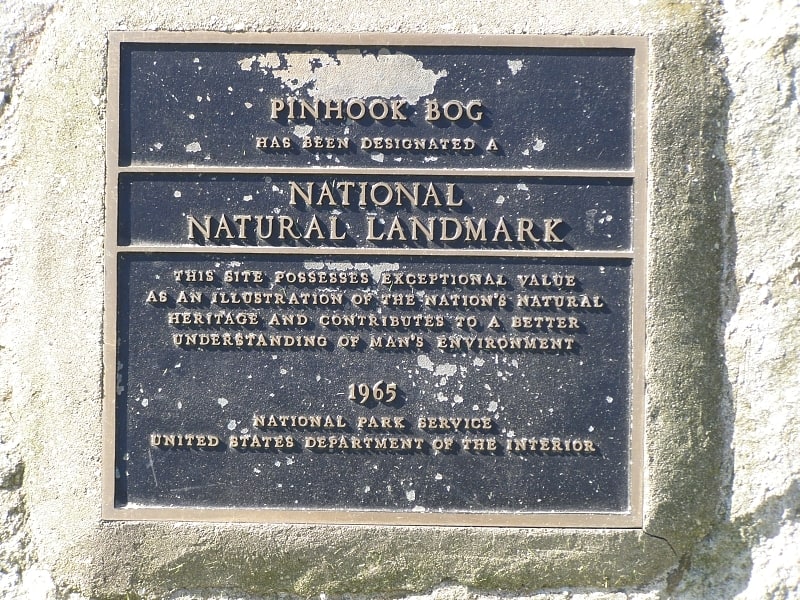
Bog in Indiana. Pinhook Bog is a unique bog in Indiana that has been designated a National Natural Landmark. It is part of Indiana Dunes National Park, an area that many citizens, scientists, and politicians fought hard to preserve. Its sister bog, Volo Bog, is located nearby. The bog contains a large variety of plants, including insect eating plants, tamarack trees, stands of blueberry bushes, and floating mats of sphagnum moss. Pinhook Bog is about 580 acres, a quarter of which is a floating mat of sphagnum peat moss. A "moat" separates the bog from the uplands.[1]
Joseph Bailly Homestead

Historical place in Porter, Indiana. The Joseph Bailly Homestead, also known as Joseph Bailly Homestead and Cemetery, in Porter, Indiana, is a U.S. National Historic Landmark.
The Bailly Homestead is preserved by the National Park Service in Indiana Dunes National Park in Porter, Indiana. The Homestead was the home of Joseph Aubert de Gaspé Bailly de Messein (1774-1835), one of the first permanent white settlers in Northwest Indiana. This homestead, begun in 1834, is one of the only surviving elements of the once-significant fur trade in the region. It received its landmark designation in 1962.
Bailly brought his family to the southern shore of Lake Michigan in 1822, first living in a log house built soon afterward. The Homestead remained in the family until the death of his granddaughter, Frances Howe, in 1917. The Homestead is sometimes referred to as the "Bailly-Howe" Home. The National Park Service acquired the Homestead on November 26, 1971.[2]
Florida Tropical House
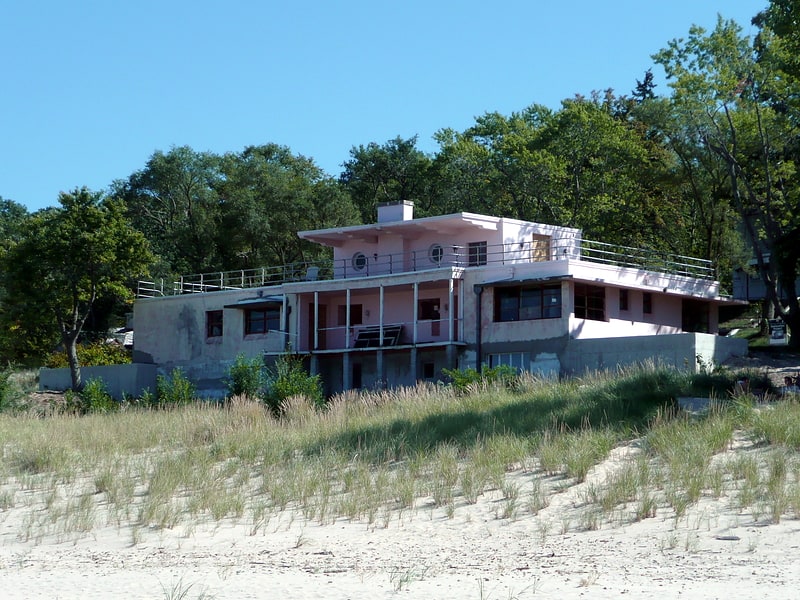
Beach house in Porter County. The Florida Tropical House is a beach house located on Lake Michigan's shoreline in Beverly Shores, Indiana. It was built in 1933 as part of the Homes of Tomorrow Exhibition at the 1933 World's Fair in nearby Chicago. Today it is part of the Century of Progress Architectural District, a historic district.
After years of disrepair, the house is being renovated and is subleased to a private renter who has agreed to cover the restoration costs. The house was designed so its inside and outside environments can be continuous. Its exterior was designed in the Modernist style by architect Robert Law Weed and painted a Floridian pink.
The house, with four other 1933 exhibition homes nearby, were added to the National Register of Historic Places in 1986. They are collectively known as the World's Fair Houses.[3]
Wieboldt-Rostone House
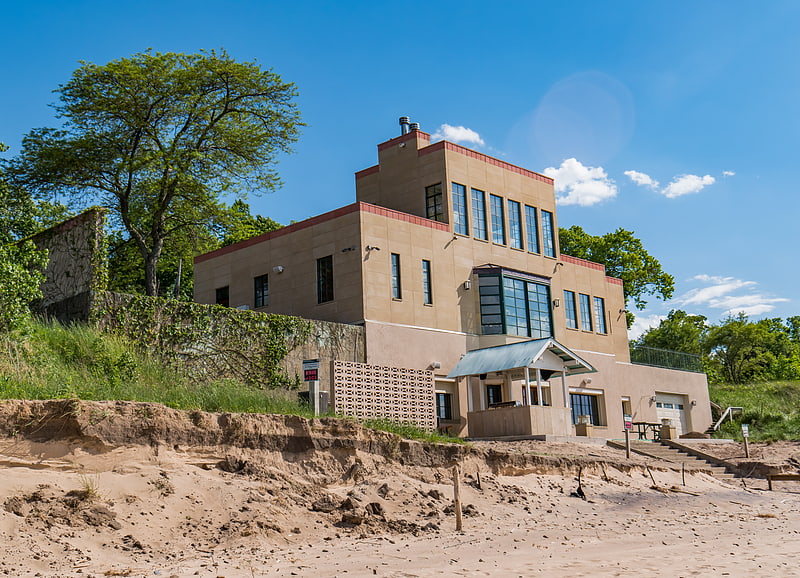
Building in Beverly Shores, Indiana. The Wieboldt-Rostone House is a historic building in the Century of Progress Architectural District in Beverly Shores, Indiana. The home was built in 1933, framed in steel, and clad with an artificial stone called Rostone. Billed as never needing repairs, it only lasted without renovations until the 1950s.
Intended to showcase a new building material of limestone waste and shale, the Rostone House was the product of Rostone, Inc. of Lafayette, Indiana, and the Indiana Bridge Company. Construction was simplified by the completion of most design and fabrication work at a factory. The panels would be precast to the correct sizes needed for a specific project. Each panel came with pre-set nuts, that would be used to bolt the panel onto the steel frame. Both the interior and exterior walls were designed this way. The house was designed by Indiana architect Walter Scholer.[4]
Armco-Ferro House
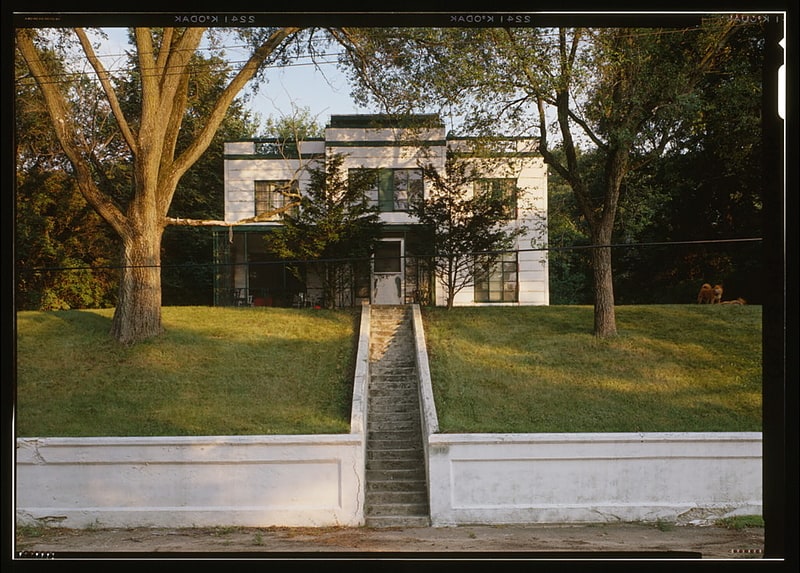
Building in Beverly Shores. The Armco-Ferro House, in the Century of Progress Architectural District in Beverly Shores, Indiana, was originally constructed for the 1933 Century of Progress Exposition in Chicago. "The.. Exposition opened in May of 1933 directed by the theme of science and its role in industrial advancement. Within the Home and Industrial Arts Group were model houses, which featured modern materials, building methods and innovative home appliances, including the Armco-Ferro-Mayflower, Wieboldt-Rostone and Florida Tropical houses, and the House of Tomorrow. All utilized new techniques of design, construction and prefabrication in an attempt to bring the out-of-date housing industry in line with more efficient manufacturing practices such as those used by the auto industry." The Home and Industrial Arts Group was the most successful venue of the Exposition. The Armco-Ferro House was designed by Robert Smith, Jr. of Cleveland, Ohio. It is the only remaining example from the exposition that met the Fair Committee's design criteria; a house that could be mass-produced and was affordable for an American family of modest means..
From research completed by the Historic American Buildings Survey (HABS): The Ferro Enamel Corporation, one of the two major sponsors for the.. house, was formed in 1930 by a merger between the Ferro Enameling Company and the Ferro Enamel and Supply Co. The idea of using porcelain enamel for residential construction was introduced by Bob Weaver, president of the newly formed company. Shortly after the merger, Charles Bacon Rowley, architect, designed a four-person house with Ferro-Enamel shingles that the company erected in Cleveland, Ohio, in July 1932.31 Despite the innovative use of ferroenamel as a cladding material, the house was built using conventional wood construction. The first porcelain-enameled frameless steel house was completed.. in South Euclid, Ohio.. Like the Armco-Ferro house, this house was designed by Robert Smith, Jr. and was built by Insulated Steel Corporation;.. In 1932, the American Rolling Mill Company (Armco).. built a second porcelainenameled frameless steel house.. using Robert Smith, Jr. as architect. The Ferro Enamel Corporation and the Insulated Steel Construction Company collaborated with Armco, thus setting the stage for the partnership that made the Century of Progress home possible.[5]
Bailly Cemetery
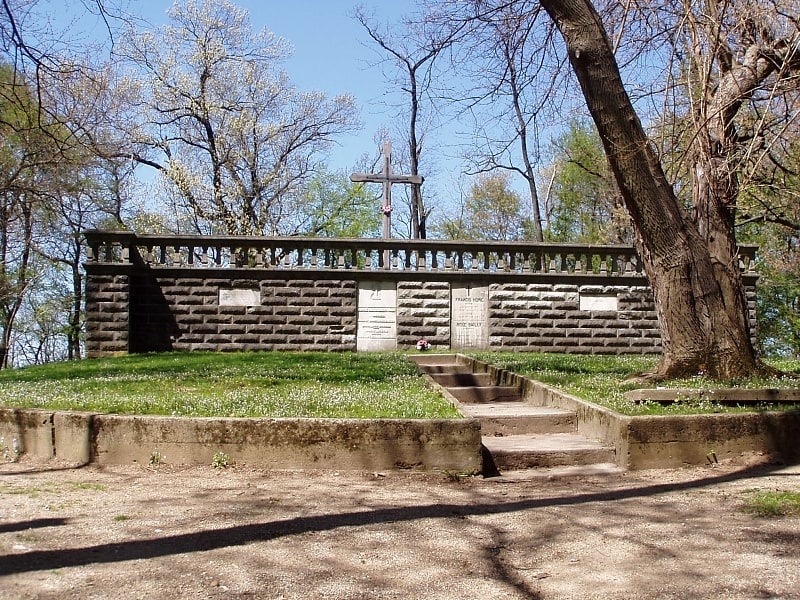
Cemetery in Porter, Indiana. Bailly Cemetery is a cemetery located at Indiana Dunes National Park in Porter, Indiana, USA. The cemetery is three-quarters of a mile north of the Joseph Bailly Homestead on the edge of a sand ridge. The first recorded burial was Robert, the son of Joseph Bailly, in about 1827. Subsequently, the site has been considered a family graveyard. Burials of those outside the Bailly family are numerous. Today, they are all unmarked, including Swedish residents of the area. Outside the cemetery platform to the north there are eight recorded tombstones, four of which are older than 1827: Isaac Schellinger, 1811; Peter Carlbon, 1814; Rhoda Schellinger, 1816; and Thomas B. Speer, 1817.[6]
Mammals of the Indiana Dunes

Thirty-seven species of mammals have been identified at Indiana Dunes National Park. Four other species are thought to inhabit the park, but have not been documented: the northern long-eared myotis, the Indiana bat, the hoary bat, and the southern bog lemming
Common mammals seen by visitors and residents include the eastern cottontail, the eastern fox squirrel, the white-footed mouse, the white-tailed deer, and the meadow vole. Extirpated mammals include the common porcupine (Erethizon dorsatum), the gray wolf (Canis lupus), the red wolf (Canis rufus), the black bear (Ursus americanus), the fisher (Pekania pennanti), the cougar (Puma concolor), the Canada lynx (Lynx canadensis), the bobcat (Lynx rufus), the elk (Cervus canadensis), and the American bison (Bison bison). There are two threatened or endangered species in the dunes. The American badger (Taxidea taxus), on the Indiana threatened list is known to inhabit the area. The Indiana bat (Myotis indiana), on the federal endangered list is presumed to inhabit areas of the dunes. Recent records, documented photographically, indicate that North American river otter (Lontra canadensis) and bobcat (Lynx rufus) began returning to the area in 2011 and 2018, respectively.[7]
House of Tomorrow
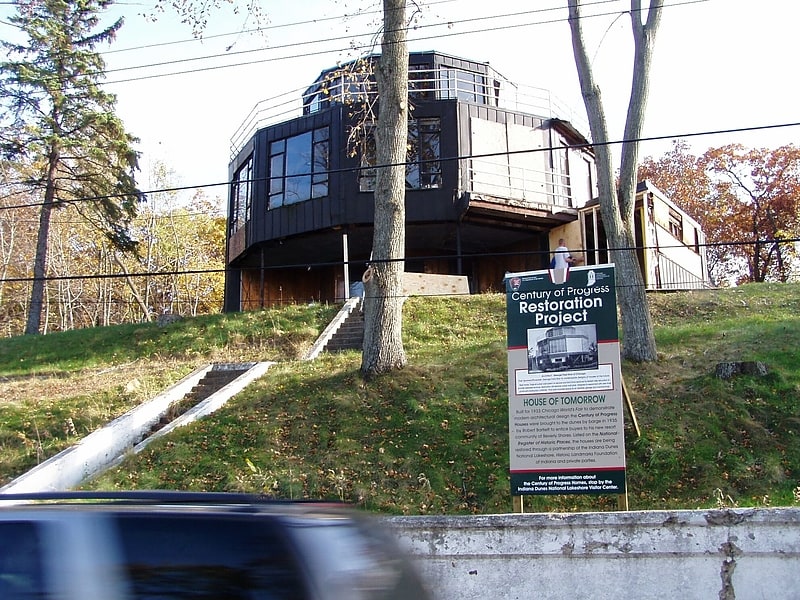
Building in Beverly Shores, Indiana. The House of Tomorrow is a historic building in the Century of Progress Architectural District in Beverly Shores, Indiana. The house was originally part of Chicago's 1933-34 Century of Progress Exposition. Designed as the house of the future, this house included its own airplane hangar. Glass walls offered views from every angle and so taxed the experimental air conditioning system that the cooling system failed.[8]
Cypress Log Cabin
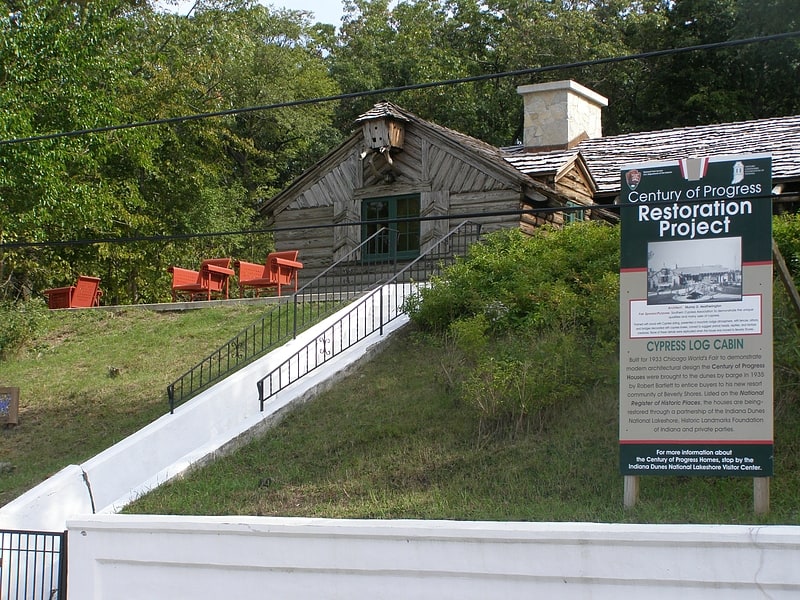
Building in Beverly Shores. Both the Cypress Log Cabin and the Cypress Guest house are historic buildings in the Century of Progress Architectural District in Beverly Shores, Indiana. The houses were sponsored by Southern Cypress Manufacturer's Association, Jacksonville, Florida. The Cypress Cabin was purchased by the Zimmernam Estate represented by Zimmerman, Saxe and MacBride, Chicago architects. It was planned to move the house to St. Joseph, Michigan, where it was to be a summer home near the Bolton exhibit building of the 1893 Columbian Exposition. The move included the Cabin, Guest House and other landscape elements. That move never happened and Robert Bartlett trucked the Cabin and Guest House to Beverly Shores. Bartlett owned the property until 1942, when sold it to Ida J. Osterburg. The house changed owners several times, until it was purchased by the National Park Service in October 1970, becoming part of Indiana Dunes National Lakeshore.
The Cypress Log Cabin was built for the 1933-34 exhibition house to demonstrate the many uses of cypress. The house was built using traditional materials rather than the experimental materials used elsewhere in the exhibition. During both seasons of the fair, Mr. and Mrs. B.R. Ellis from the Southern Cypress Association lived in the ell of the house.[9]
Invertebrates of the Indiana Dunes
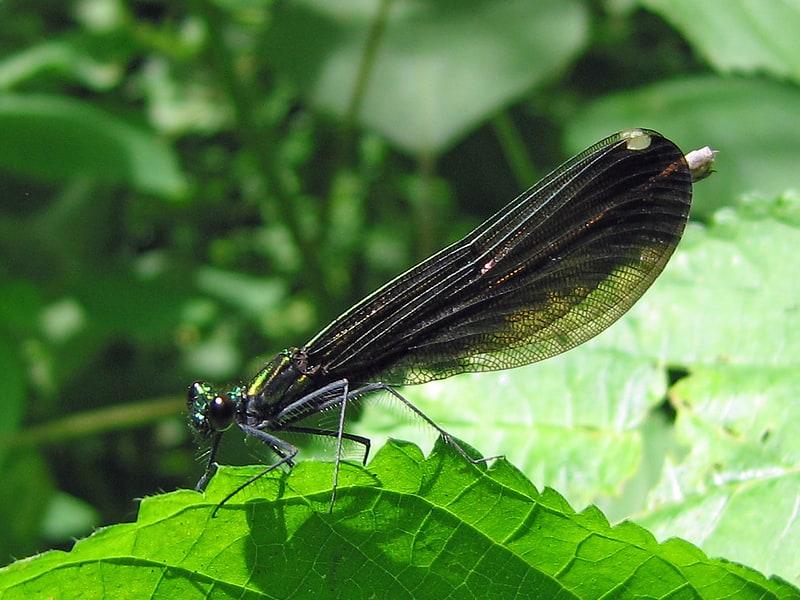
Indiana Dunes National Park is a National Park Service unit on the shore of Lake Michigan in Indiana, United States. A BioBlitz took place there on May 15 and 16, 2009. During that time, a list of organisms was compiled which included invertebrates.[10]
Solomon Enclave
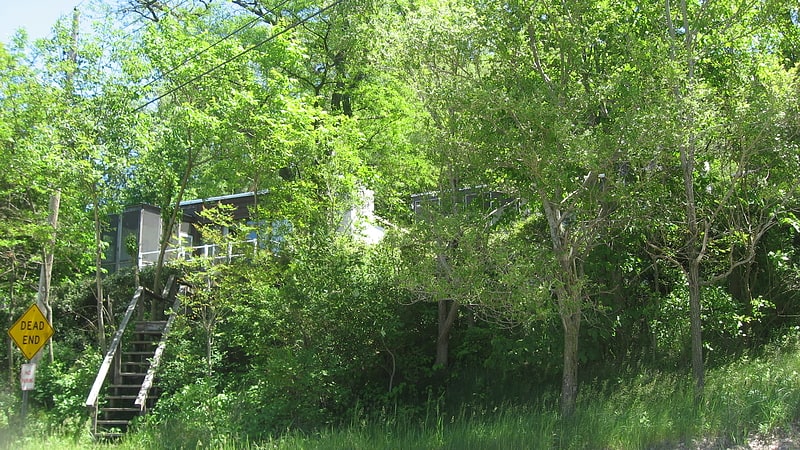
Solomon Enclave is three historic homes located at Beverly Shores, Porter County, Indiana. The three two-story, International Style flat-roofed dwellings were built in 1948. They are rectangular in plan and are built into the sides of dunes. The houses features cantilevered concrete decks that overlook Lake Michigan.
It was listed on the National Register of Historic Places in 2011.[11]